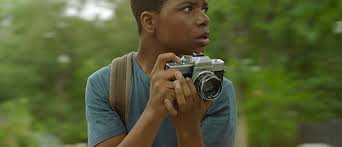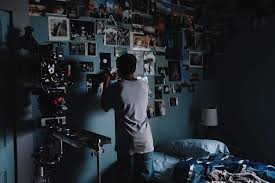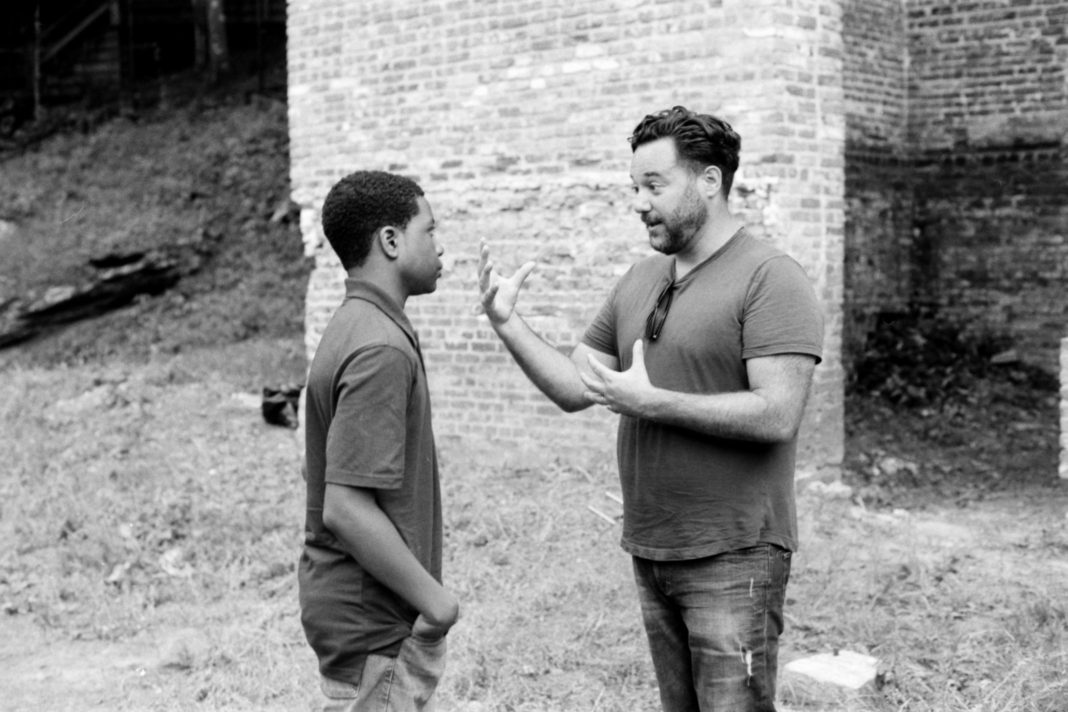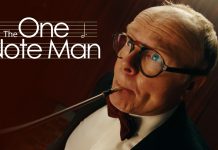In a seemingly Digital Media-based environment, it is refreshing to see a film-maker embracing the idea of an old-school format that forms the basis and backstory to a heart-warming short about a young boy’s discover of 35mm Still Photography.
Richard Raymond’s A MILLION EYES is getting a screening at this year’s Raindance Film Festival in London, having had already garnered acclaim in the circuit. A bonus in this is that the film co-stars Joe Morton, whom you may recognize from the likes of TERMINATOR 2 (1991) (Miles Dyson) and SPEED (1994) (as Keanu Reeves’ and Jeff Daniels’ superior officer.
Film and TV Now interviewed the Director about the film and his reflections on the medium itself.

FILM AND TV NOW: An old 35mm still camera is a symbolism in this film and the bond between the kid and the man played by Joe Morton. Was this always the symbol that you wanted to use in the film?
RICHARD RAYMOND: A Million Eyes echos how young kids experience that first spark of interest in the arts. That birth of light and a fragile impulse to know more. The maturation of an artist, the journey of an artist is a serious commitment and a life long path and the broken camera represents the conflict which comes with the inherent question — how do I actually realize what I can see in my mind? We want to express ourselves and share it with other people but it’s never easy. There’s so many obstacles to overcome. Hence why Joe Morton’s character is so critical. He reminds us of the importance that mentors play in young children’s lives, especially those discovering their artistic voices. The journey of an artist is a fragile one and kids need support and encouragement. It’s so important, especially to those kids in underfunded communities who feel they don’t have any value. They do and in fact they have the most important voices.
FTVN: Talking of Joe Morton, how did he get on board with the film, given his high-profile in films like SPEED and TERMINATOR 2?
RR: It’s thanks to Katie Lowes. She was the first person we had cast in the film and had started to develop it closely with her. When Joe Morton’s name came up in the spirit of “dream casting”, Katie reminded me that she’d done 8 seasons of the ABC series “Scandal” with him. She quickly called him up and asked him to read the script! It’s testament to how much Katie is respected and loved across the film industry that Joe took such a leap of faith! I had to pinch myself a few times on set. He’s a living legend and to work with an actor of his calibre was not just an incredible experience, but also a deeply collaborative one. For Joe, the film is about hope, growth, mentorship, and the legacy of artists, like Gordon Parks, who paved the way for today’s American artists of color.
FTVN: We note that Bradley Cooper is a Co-Executive Producer on the film. How did he get involved and how has his attachment changed the dynamic of the film in terms of exposure?
RR: I do laugh every time someone asks me this, who would’ve thought people actually read the end credits! It’s a different Bradley Cooper than the one you are thinking of! This particular Bradley lives in New York and runs a private equity firm, who on the side likes to invest in meaningful projects. In fact his young daughter, Carly, worked on the film and became an indispensable member of the crew.
FTVN: Where did you shoot?
RR: We shot all over Atlanta, Georgia. The lush green suburbs really played into the whole nature fighting back theme of the film. The sounds of cicadas, the blistering heat and the rolling thunderstorms. It’s such a distinctive place, I just love it. Also the film crews in Atlanta are some of the very best in the world. I’m so blessed that our producing partner, Erin Charles, crewed up the whole film with such incredible local talent. It felt like a community of “we can do this!”.
FTVN: Tell us about the lead actor and actress who play the troubled teen and the recovering mother.
RR: When it comes to Elijah M. Cooper, who plays Leroy, I thank the universe for our amazing casting director, Chad Darnell. His discovery of Elijah, just 13 years old in his first ever film role, was the one miracle we needed for the film to work.
From his very first audition I could see that Elijah had a natural charisma and presence, which isn’t something that can be taught. He brought his own perspective and introverted interpretation to the part. He was a delight to work with, as was his incredibly supportive family who were with us each day. One of the things I loved about Elijah was how he stayed in character on set. To do that takes a lot of maturity and focus, which for his age is rare. I think we’ll be seeing a lot more of him in the future.
Regarding his on-screen mother, I have to give praise to Katie Lowes, who plays Amber. She was extremely collaborative and generous with her time and energy. She bonded genuinely with Elijah and brought such a uniquely human perspective to her character. We’re all flawed in so many ways and Katie wanted to show all the shades of grey with Amber. Here is a mother who has lost the great love of her life and now she’s raising her son alone in a discarded house, which is both decaying and full of painful memories.
She’s hurting, but she’s keeping it boxed in while trying her best. It was important to Katie that despite the choices Amber makes, the audience roots for her. There’s nothing to demonize. There’s certainly no judgement from her son, who thinks the world of her and more of less looks after her. In the end, because of Leroy’s art, Amber’s arc is one of acceptance. She’s no longer going to hide. She’s going to face the pain head on.
There’s a certain sense of healing about the ending I think. We feel that she’s going to be okay. Now having said all this, you can write that in a script, but for an audience to feel it — that’s all down to Katie’s understated and beautifully subtle performance. She’s a gift to any director, who seems to make everything she does look effortless.
Most people recognise Katie from ABC’s “Scandal”, but there’s so much more to discover. She trained at schools like RADA and Tisch,. Katie’s also the co-artistic director and co-founder of a brilliant theatre company in Los Angeles called IAMA, which she spearheads with huge amount of passion and vigor.

FTVN: The cinematography is beautifully rendered. Tell us about your Cinematographer.
RR: Thank you. It’s my second film with Jarin Blaschke. We wanted A Million Eyes to be precise but at the same time fluid. One of the early references for me was David Gordon Green’s 2003 film “George Washington”, but we ended up going with a much more classical and patient visual approach.
The film is shot in the 5.1 Aspect Ratio, which is the same as a stills camera and many shots are frames within frames. When it comes to lighting Jarin is a poet. I’m such a fan of his previous work like “The Witch”, and his upcoming “The Lighthouse”.
I don’t think there’s anyone like him working today. He is obsessed with 35mm photography and to harness that knowledge on a film that’s about that same medium was a gift.
FTVN: Today, with the advent of a more Digital rather than Physical film world, do you think this film could spark an interest and resurgence in the idea and potential of using standard 35mm still film photography?
RR: Not only has a resurgence already begun, but streams of young artists are discovering 35mm film for the first time and embracing it as the go to medium. Digital photography offers instant gratification but film has an enduring, authentic appeal.
It doesn’t just enable your work to stand out from the crowd, and look incredible, but shooting film gives you no choice but to slow down, compose a shot, think, reflect and wait for the right moment. Because film has limits you are forced to use every frame judiciously. It’s not like a memory card. You can’t shoot 10,000 photos and hope that a couple of them turn out. You have to think about every shot. It activates your creativity.
FTVN: You are of British origin, yet you are filming a quintessential American-set movie. How did you make the transition across the pond?
RR: I grew up in Hertfordshire, just north of London, but I’ve felt a calling to live in the US since I was a young boy. I was always fascinated with the allure of the American film industry. I certainly wanted to be in the heart of where the films I saw growing up get made. But when I got here only then did I discover that not much, if anything, is actually shot in Los Angeles! But now it’s too late.
I met an American girl, fell in love, had two beautiful children and there’s no turning back. I do love how transient Los Angeles is, just by being here you get to meet some incredible people because at some point everyone comes to visit. That and the weather.
FTVN: How long did it take to shoot?
RR: 5 days, which sounds a lot for a short but we had 41 scenes and could only work 7 hours a day with Elijah, as he’s only 13 years old.
FTVN: How did you raise finance for the film?
RR: That’s all down to my wife and producer, Nousha Raymond. Raising money for a short film is always going to be somewhat of a miracle and she’s a relentless miracle-worker. She gathered together a group of individuals who all believed in the message of A Million Eyes and wanted to support us.
They were spearheaded by some of the most brilliant women I’ve have the honor of knowing. People like Suzie Brown, Jen Beerman, Kate McCormack, Louise Griffiths, Tamar Tenenbaum, Ana VonBurg Martiny, Alexandra Roubeni and Cynthia Rose — to name only a few.
FTVN: How has the festival experience been for you?
RR: What could be better than sharing your work with audiences around the world? I get to meet a global community of emerging filmmakers, who are taking risks and challenging the status quo. It’s so inspiring to be surrounded by so many diverse voices who in turn challenge your point of view and have an impact on your own work.
I also realized that successful short films actually receive a greater theatrical release over the course of their festival run than many low budget indie feature films. There’s equal value across the two mediums. Understanding that was liberating for me. Short films are not a stepping stone, they are a distinct medium in which you can tell important stories to a global audience.
FTVN: Finally, what are your hopes and ambitions for the film and would you like to do more similar-themed films?
RR: Absolutely. I hope A Million Eyes reminds audiences of the importance of mentors in young children’s lives, especially those discovering their artistic voices. And helps to recognise the significance that arts education has on kids, especially those in underfunded communities who feel they don’t have any value. They do and in fact they have the most important voices.
For more about the Raindance Film Festival, click here.





























